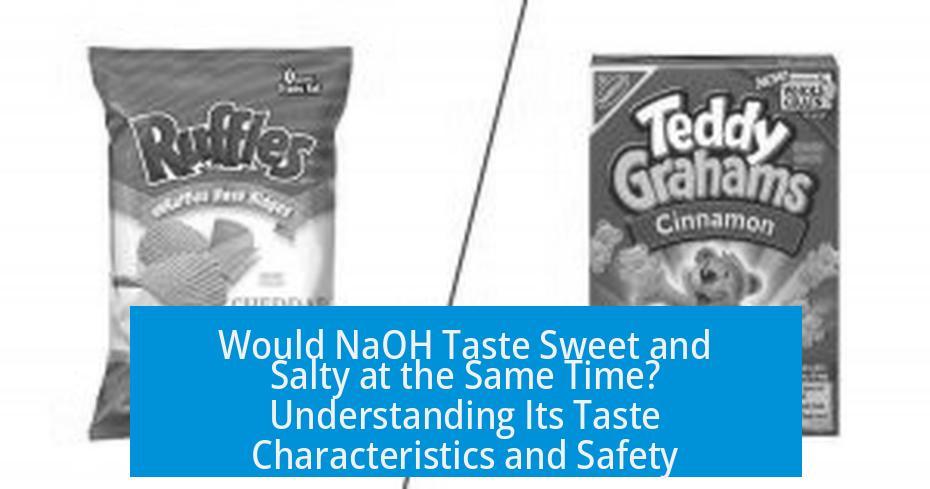Would NaOH Taste Sweet and Salty Simultaneously?
Sodium hydroxide (NaOH) does not taste sweet and salty at the same time. It mainly tastes bitter and soapy, with a possible slight salty note, but the sweet flavor is absent due to fundamental chemical differences from sugars.
Taste Characteristics of Sodium Hydroxide
NaOH’s taste is dominated by bitterness and a soapy sensation. This happens because NaOH chemically reacts with the fats in the tissues on the tongue. The base saponifies these lipids, essentially turning them into soap. This reaction causes a distinctly soapy taste rather than a sweet or purely salty one.
- The bitter taste is typical of strong bases like NaOH.
- The soapy flavor directly results from the saponification of mouth fats by hydroxide ions.
- There is often a burning or painful sensation shortly after contact with NaOH due to its corrosive nature.
Some individuals report a slight salty note, but it is minimal and not prominent. This saltiness, if detected, likely comes from the sodium ions present in NaOH, although sodium ion alone does not produce a strong salty flavor. Sodium’s salty taste is more pronounced when paired with chloride ions, which are absent in pure NaOH.
Why NaOH Is Not Sweet
Sweetness depends on how molecules interact with specific taste receptors. Sugars contain hydroxyl (-OH) groups covalently bonded in particular arrangements. These shapes fit sweetness receptors on the tongue. Although NaOH contains hydroxide ions (OH−), these are very different chemically and structurally from hydroxyl groups in sugar.
- Sugars have complex three-dimensional shapes enabling receptor binding.
- Hydroxyl groups in sugars are part of a stable molecule, unlike the free hydroxide ions in NaOH.
- NaOH dissociates into free sodium and hydroxide ions in solution, which raise pH and act as a strong base, not as a sweet molecule.
This fundamental difference means NaOH cannot stimulate sweetness receptors, making it taste unpleasantly bitter and soapy rather than sweet.
Role of Sodium and Other Ions in Taste
The salty taste in foods often comes from sodium chloride (table salt), where sodium ions combine with chloride ions. Chloride ions significantly contribute to the salty sensation. In pure NaOH, chloride ions are absent, so the salty taste is weak or almost non-existent.
- Sodium ions alone do not strongly evoke a salty taste.
- Other sodium salts like sodium bicarbonate or monosodium glutamate produce different taste experiences.
- Without chloride ions, salty sensation from NaOH remains faint.
Additional Sensory and Safety Considerations
NaOH is highly caustic and damaging to tissues. Its initial taste may be experienced as bitter and soapy, followed quickly by pain and burning. Contact with NaOH can cause chemical burns in the mouth and damage taste receptors, severely affecting taste perception.
Interestingly, NaOH finds use in food processing (e.g., lutefisk), where its alkaline properties alter texture and protein content. Yet, the substance remains unsafe to taste directly at the concentrations used for such treatments.
Summary of Key Points
- NaOH tastes mainly bitter and soapy due to saponification of mouth fats.
- It does not taste sweet because hydroxide ions differ from the hydroxyl groups in sugars needed to activate sweet receptors.
- Any salty taste is minimal and derives from sodium ions, but pure NaOH lacks chloride ions, which are essential for strong saltiness.
- NaOH causes a burning sensation and chemical damage, limiting taste perception shortly after initial contact.
- Sweet and salty tastes do not coexist in NaOH; the dominant sensations are bitter, soapy, and painful.
Does NaOH taste sweet and salty at the same time?
No. NaOH mainly tastes bitter and soapy. It does not have a sweet taste because hydroxide ions differ from sugar’s sweet hydroxyl groups. Any salty note is very faint and mostly not noticeable.
Why does NaOH taste soapy rather than sweet?
NaOH turns fats in your mouth into soap, causing a soapy taste. The hydroxyl groups in sugars are part of a specific molecular shape that triggers sweetness, which NaOH lacks.
Can NaOH taste salty due to sodium ions?
Sodium ions alone have little to no salty taste. Saltiness usually comes from chloride ions, which are absent in NaOH. Thus, any salty taste from NaOH is minimal or missing.
What sensations does NaOH cause besides taste?
NaOH causes a burning sensation and pain. It can damage mouth tissues quickly, overpowering taste and causing chemical burns rather than distinct flavors.
Is it safe to taste NaOH to detect its presence?
Tasting NaOH is dangerous because it is corrosive and causes burns. It can damage taste buds and mouth tissue. Safety precautions should always be taken to avoid contact.




Leave a Comment